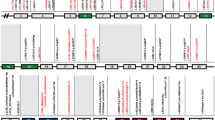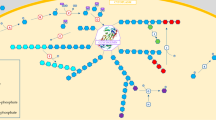Abstract
Glycogen storage disease type VI (GSD-VI; also known as Hers disease, liver phosphorylase deficiency) is caused by mutations in the gene coding for glycogen phosphorylase (PYGL) leading to a defect in the degradation of glycogen. Since there are only about 40 patients described in literature, our knowledge about the course of the disease is limited. In order to evaluate the long-term outcome of patients with GSD-VI, an observational retrospective case study of six patients was performed at the University Children’s Hospital Zurich. The introduction of small, frequent meals as well as cornstarch has led to normal growth in all patients and to normalization of liver transaminases in most patients. After starting the dietary regimen, there were no signs of hypoglycemia. However, three of six patients showed persistent elevation of triglycerides. Further, we identified four novel pathogenic PYGL mutations and describe here their highly variable impact on phosphorylase function.
Conclusions: After establishing the diagnosis, dietary treatment led to metabolic stability and to prevention of hypoglycemia. Molecular genetics added important information for the understanding of the clinical variability in this disease. While outcome was overall excellent in all patients, half of the patients showed persistent hypertriglyceridemia even after initiating treatment.
What is Known: • Glycogen storage disease type VI (GSD-VI) is a metabolic disorder causing a defect in glycogen degradation. Dietary treatment normally leads to metabolic stability and prevention of hypoglycemia. • However, our knowledge about the natural course of patients with GSD-VI is limited. | |
What is New: • While outcome was overall excellent in all patients, half of the patients showed persistent hypertriglyceridemia even after initiating treatment. • Molecular genetics added important information for the understanding of the clinical variability in this disease. |



Similar content being viewed by others
Abbreviations
- ALT:
-
Alanine transaminase
- AST:
-
Aspartate transaminase
- BTN:
-
Biotinidase
- DNA:
-
Deoxyribonucleic acid
- EBV:
-
Epstein-Barr virus
- f:
-
Female
- GSD:
-
Glycogen storage disease
- GSD-VI:
-
Glycogen storage disease type VI
- HM:
-
Hepatomegaly
- LE:
-
Liver enzymes
- m:
-
Male
- mRNA:
-
Messenger RNA
- PBK:
-
Phosphorylase b-kinase
- PYGL :
-
Glycogen phosphorylase
- RBC:
-
Red blood cells
References
Wolfsdorf JI, Holm IA, Weinstein DA (1999) Glycogen storage diseases. Phenotypic, genetic, and biochemical characteristics, and therapy. Endocrinol Metab Clin North Am 28(4):801–823
Hers HG (1959) Enzymatic studies of hepatic fragments; application to the classification of glycogenoses. Rev Int Hepatol 9(1):35–55
Chang S, Rosenberg MJ, Morton H, Francomano CA, Biesecker LG (1998) Identification of a mutation in liver glycogen phosphorylase in glycogen storage disease type VI. Hum Mol Genet 7(5):865–870
Burwinkel B, Bakker HD, Herschkovitz E, Moses SW, Shin YS, Kilimann MW (1998) Mutations in the liver glycogen phosphorylase gene (PYGL) underlying glycogenosis type VI. Am J Hum Genet 62(4):785–791
Dagli AI, Weinstein DA (1993) In: Adam MP, Ardinger HH, Pagon RA et al (eds) Glycogen storage disease type VI. GeneReviews((R)), Seattle (WA)
Newgard CB, Fletterick RJ, Anderson LA, Lebo RV (1987) The polymorphic locus for glycogen storage disease VI (liver glycogen phosphorylase) maps to chromosome 14. Am J Hum Genet 40(4):351–364
Newgard CB, Nakano K, Hwang PK, Fletterick RJ (1986) Sequence analysis of the cDNA encoding human liver glycogen phosphorylase reveals tissue-specific codon usage. Proc Natl Acad Sci U S A 83(21):8132–8136
Elpeleg ON (1999) The molecular background of glycogen metabolism disorders. J Pediatr Endocrinol Metab 12(3):363–379
Beauchamp NJ, Taybert J, Champion MP, Layet V, Heinz-Erian P, Dalton A, Tanner MS, Pronicka E, Sharrard MJ (2007) High frequency of missense mutations in glycogen storage disease type VI. J Inherit Metab Dis 30(5):722–734. https://doi.org/10.1007/s10545-007-0499-9
Kishnani PS, Goldstein J, Austin SL, Arn P, Bachrach B, Bali DS, Chung WK, El-Gharbawy A, Brown LM, Kahler S, Pendyal S, Ross KM, Tsilianidis L, Weinstein DA, Watson MS, Diagnosis AWGo, Management of glycogen storage diseases type VI, Ix (2019) Diagnosis and management of glycogen storage diseases type VI and IX: a clinical practice resource of the American College of Medical Genetics and Genomics (ACMG). Genet Med 21(4):772–789. https://doi.org/10.1038/s41436-018-0364-2
Nakai A, Shigematsu Y, Takano T, Kikawa Y, Sudo M (1994) Uncooked cornstarch treatment for hepatic phosphorylase kinase deficiency. Eur J Pediatr 153(8):581–583
Roscher A, Patel J, Hewson S, Nagy L, Feigenbaum A, Kronick J, Raiman J, Schulze A, Siriwardena K, Mercimek-Mahmutoglu S (2014) The natural history of glycogen storage disease types VI and IX: Long-term outcome from the largest metabolic center in Canada. Mol Genet Metab 113(3):171–176. https://doi.org/10.1016/j.ymgme.2014.09.005
Willems PJ, Gerver WJ, Berger R, Fernandes J (1990) The natural history of liver glycogenosis due to phosphorylase kinase deficiency: a longitudinal study of 41 patients. Eur J Pediatr 149(4):268–271
Smit GP, Fernandes J, Leonard JV, Matthews EE, Moses SW, Odievre M, Ullrich K (1990) The long-term outcome of patients with glycogen storage diseases. J Inherit Metab Dis 13(4):411–418
Manzia TM, Angelico R, Toti L, Cillis A, Ciano P, Orlando G, Anselmo A, Angelico M, Tisone G (2011) Glycogen storage disease type Ia and VI associated with hepatocellular carcinoma: two case reports. Transplant Proc 43(4):1181–1183. https://doi.org/10.1016/j.transproceed.2011.01.129
Ogawa A, Ogawa E, Yamamoto S, Fukuda T, Sugie H, Kohno Y (2010) Case of glycogen storage disease type VI (phosphorylase deficiency) complicated by focal nodular hyperplasia. Pediatr Int 52(3):e150–e153. https://doi.org/10.1111/j.1442-200X.2010.03073.x
Schwartz D, Savin M, Drash A, Field J (1970) Studies in glycogen storage disease. IV. Leukocyte phosphorylase in a family with type VI GSD. Metabolism 19(3):238–245
Davit-Spraul A, Piraud M, Dobbelaere D, Valayannopoulos V, Labrune P, Habes D, Bernard O, Jacquemin E, Baussan C (2011) Liver glycogen storage diseases due to phosphorylase system deficiencies: diagnosis thanks to non invasive blood enzymatic and molecular studies. Mol Genet Metab 104(1-2):137–143. https://doi.org/10.1016/j.ymgme.2011.05.010
Tang NL, Hui J, Young E, Worthington V, To KF, Cheung KL, Li CK, Fok TF (2003) A novel mutation (G233D) in the glycogen phosphorylase gene in a patient with hepatic glycogen storage disease and residual enzyme activity. Mol Genet Metab 79(2):142–145
Buchbinder JL, Rath VL, Fletterick RJ (2001) Structural relationships among regulated and unregulated phosphorylases. Annu Rev Biophys Biomol Struct 30:191–209. https://doi.org/10.1146/annurev.biophys.30.1.191
Rath VL, Ammirati M, LeMotte PK, Fennell KF, Mansour MN, Danley DE, Hynes TR, Schulte GK, Wasilko DJ, Pandit J (2000) Activation of human liver glycogen phosphorylase by alteration of the secondary structure and packing of the catalytic core. Mol Cell 6(1):139–148
Barford D, Johnson LN (1989) The allosteric transition of glycogen phosphorylase. Nature 340(6235):609–616. https://doi.org/10.1038/340609a0
Wrabl JO, Grishin NV (2001) Homology between O-linked GlcNAc transferases and proteins of the glycogen phosphorylase superfamily. J Mol Biol 314(3):365–374. https://doi.org/10.1006/jmbi.2001.5151
Palm D, Klein HW, Schinzel R, Buehner M, Helmreich EJ (1990) The role of pyridoxal 5'-phosphate in glycogen phosphorylase catalysis. Biochemistry 29(5):1099–1107. https://doi.org/10.1021/bi00457a001
Derks TG, Smit GP (2015) Dietary management in glycogen storage disease type III: what is the evidence? J Inherit Metab Dis 38(3):545–550. https://doi.org/10.1007/s10545-014-9756-x
Rake JP, Visser G, Labrune P, Leonard JV, Ullrich K, Smit GP (2002) Glycogen storage disease type I: diagnosis, management, clinical course and outcome. Results of the European Study on Glycogen Storage Disease Type I (ESGSD I). Eur J Pediatr 161(Suppl 1):S20–S34. https://doi.org/10.1007/s00431-002-0999-4
Derks TG, van Rijn M (2015) Lipids in hepatic glycogen storage diseases: pathophysiology, monitoring of dietary management and future directions. J Inherit Metab Dis 38(3):537–543. https://doi.org/10.1007/s10545-015-9811-2
Fagerberg L, Hallstrom BM, Oksvold P, Kampf C, Djureinovic D, Odeberg J, Habuka M, Tahmasebpoor S, Danielsson A, Edlund K, Asplund A, Sjostedt E, Lundberg E, Szigyarto CA, Skogs M, Takanen JO, Berling H, Tegel H, Mulder J, Nilsson P, Schwenk JM, Lindskog C, Danielsson F, Mardinoglu A, Sivertsson A, von Feilitzen K, Forsberg M, Zwahlen M, Olsson I, Navani S, Huss M, Nielsen J, Ponten F, Uhlen M (2014) Analysis of the human tissue-specific expression by genome-wide integration of transcriptomics and antibody-based proteomics. Mol Cell Proteomics 13(2):397–406. https://doi.org/10.1074/mcp.M113.035600
Acknowledgments
We would like to thank the families for their willingness to be part of this project.
Author information
Authors and Affiliations
Contributions
Tim Aeppli and Johannes Häberle designed the study. Tim Aeppli collected the data, carried out the analysis, created the tables, and drafted the manuscript. Daisy Rymen analyzed the different PYGL mutations and wrote the “Diagnostic workup” section. Peter Bode performed the histological workup. Gabriella Allegri created the graphs. All the authors reviewed and revised the manuscript draft and approved the final manuscript.
Corresponding author
Ethics declarations
Conflict of interest
The authors declare that they have no conflict of interest.
Ethical approval and consent
We received parental consent for publication of patient-related data, which is commensurate to IRB approval according to local regulations.
Additional information
Publisher’s note
Springer Nature remains neutral with regard to jurisdictional claims in published maps and institutional affiliations.
Rights and permissions
About this article
Cite this article
Aeppli, T.R., Rymen, D., Allegri, G. et al. Glycogen storage disease type VI: clinical course and molecular background. Eur J Pediatr 179, 405–413 (2020). https://doi.org/10.1007/s00431-019-03499-1
Received:
Revised:
Accepted:
Published:
Issue Date:
DOI: https://doi.org/10.1007/s00431-019-03499-1




